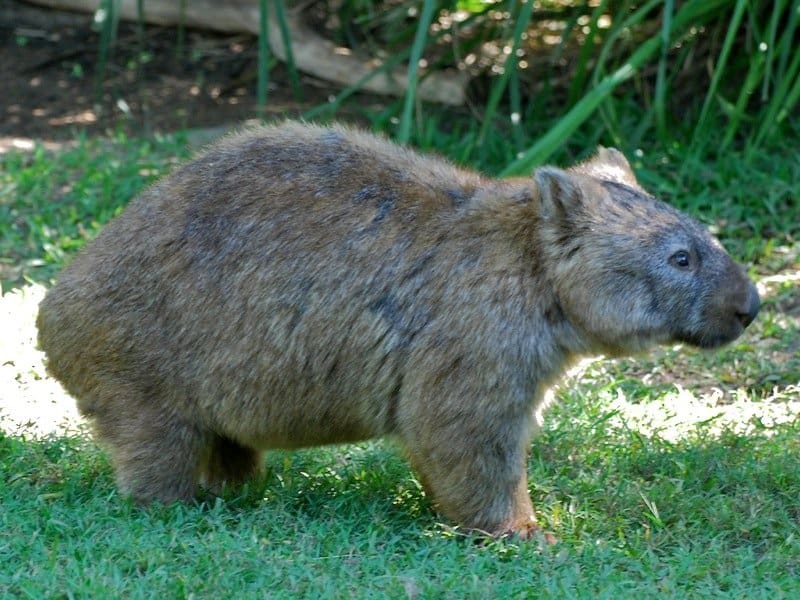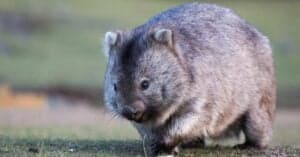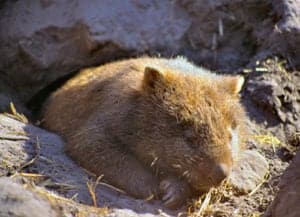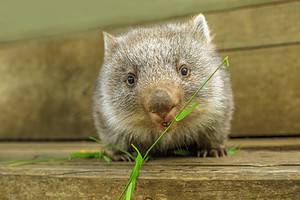When one thinks they have encountered and seen different animals on the planet, a weird creature appears out of the blue. Interestingly, wombats are our animal focus in this article, and they have surprisingly unique physical features similar to rodents.
The wombat is a marsupial native to Australia and the surrounding islands. They are often referred to as any of the stocky Australian marsupials of the Vombatidae family, distinguished by their short legs, short tails, huge heads, and small ears.
Fascinatingly, these little mammals effortlessly blend in with the surrounding environment to evade predators daily with their sandy brown and grayish-black fur color. Wombats are blessed with muscular pectoral girdle, forepaws, strong claws, and broad humerus, which assist them in their digging habit. In this article, we will find out if wombats are dangerous.
Are Wombats Dangerous?

If they feel threatened, wombats could get aggressive.
©Sander Groffen/Shutterstock.com
Wombats’ burrowing can cause crop and pasture damage, which can be a pain for ranchers and farmers. Unfortunately, courtesy of displacement of natural space, these animals over the years have been believed to be amongst the categories of wild animals known to be disease carriers, crop and livestock destroyers.
Wombats attack intruders and defend their territory, with the common wombat covering a range of approximately 23 hectares (57 acres), whereas the hairy-nosed wombats have significantly lower ranges of 4 hectares (10 acres).
Where Do Wombats Live?

Wombats are found only in Australia or Tasmania.
All wombat species live in burrows, which can be intricate networks of tunnels and chambers with a radius of 650 ft. Fascinatingly, almost all wombats are solitary and find comfort in their burrows. Whimpering at invaders, rubbing their scent on trees, and spreading cube-shaped droppings are all ways they mark their territory. The peculiar shape of their feces aids in the retention of their territorial markings. The wombat has a stumbling pace and a robust barrel-like body with short, muscular legs and long flat claws. A common wombat’s home range can contain twelve tunnels with three to four major burrows. A network of sub tunnels with several entries and sleeping areas are housed in the main burrow, while wombats dig these tunnels in well-drained soils, frequently near rivers and gullies.
How Do Wombats Give Birth to Their Young?
After a 22-day gestation period, female wombats often give birth to a small, underdeveloped joey in the spring, which creeps into its mother’s pouch. Interestingly, this pouch accommodates the single joey for 7 to 10 months until 12 to 15 months old when it leaves to care for itself. Wombats are fully weaned within 11 to 15 months and reach sexual maturity at 18 months.
The joey spends roughly five months in its mother’s pouch before emerging, and even after it has left the pouch, it routinely returns to be nursed. Unlike that of other female marsupials, the pouch of the wombat is positioned backward and opens toward its rear. Courtesy of its pouch’s position, the baby joey is protected from dirt when the mother wombat burrows.
What Do Wombats Eat?

Wombats are nocturnal creatures that feed at night. Their incisors, which resemble a rodent’s, never stop growing as they keep themselves healthy with their vegetarian diets. Wombats majorly eat plants and, by default, are herbivores. They spend 3 to 8 hours foraging most native grasses, including wallaby grass, sedges, herbs, tree barks, fungi, and roots in the night. Unfortunately, some of their diets are difficult to digest, but luckily, their unique stomach glands helps them digest these meals as soon as possible.
How Do Wombats Burrow?
Wombats excavate tunnels in open grasslands and eucalyptus woods using their strong claws. They dwell in caves that can grow into large tunnel-and-chamber complexes when they are not feeding at night. Other wombats are more gregarious and dwell in bigger burrow groupings called colonies, but common wombats are solitary and live in their burrows. These tiny mammals aren’t as common as other animals, but they leave plenty of proof of their presence and produce unique cubic scat.
Do Wombats Pose a Threat to Humans?
Wombat claws, as well as bites, can cause puncture wounds in humans. They can charge at humans when startled and knock them down, resulting in shattered bones. Harry Frauca, a naturalist, was once bitten 0.8 inches into the flesh of his leg, despite wearing a rubber boot, trousers, and thick woolen socks.
How Do Wombats Defend Themselves From Predators?
Unfortunately, wombats are often hunted by foxes, Eastern quolls, eagles, dingoes, and Tasmanian Devils. Wombats can mobilize enormous power reserves when attacked. Their hardened rear hide, with most of the posterior form of cartilage, is their principal defense. This, combined with the wombat’s teeny-tiny tail, makes it extremely difficult for any predator who follows it into its burrow to bite or hurt it. Wombats move slowly in general, but they sprint for short periods when endangered.
What Dangers Do Wombats Face?
Wombats face various threats, including habitat deterioration owing to urban growth and contemporary forestry techniques, food competition with rabbits and livestock, rabbit poisoning, poaching, road accidents, and diseases like mange, which foxes spread.
Fun Facts about Wombats
- Three-quarters of a wombat’s time is spent in its burrow.
- When a wombat sleeps, it can reduce its metabolism by a third, lowering its heartbeat and respiration to preserve energy.
- Wombats sleep on their backs with their legs in the air when they are not agitated by the rigors of daily activities.
- When sleeping, wombats sometimes snore.
- These stocky marsupials are quick runners.
- Wombats are known for producing cubed-shaped excrement, which they produce in large quantities per day (about 100).
- Wombats typically have only one joey, which is blind and hairless and weighs less than one-tenth of an ounce.
- Due to their horizontal structure, these little mammals have considerably fewer spinal problems than koalas and humans.
The photo featured at the top of this post is © Martin Pelanek/Shutterstock.com
Thank you for reading! Have some feedback for us? Contact the AZ Animals editorial team.






